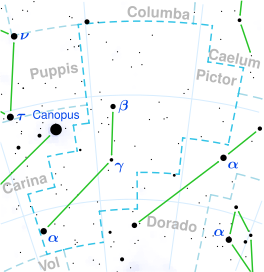Alpha Pictoris
| Alpha Pictoris
| ||||

| ||||
| Die ligging van Alpha Pictoris (in die rooi sirkel). | ||||
| Sterrebeeld | Skilder | |||
| Spektraaltipe | A8 Vn kA6[1] | |||
| Soort | Hoofreeksster | |||
| Waarnemingsdata (Epog J2000) | ||||
| Regte klimming | 06h 48m 11.45512s[2] | |||
| Deklinasie | -61° 56′ 29.0008″[2] | |||
| Skynmagnitude (m) | 3,27[3] | |||
| Absolute magnitude (M) | 0,86[4] | |||
| B-V-kleurindeks | +0,21[3] | |||
| U-B-kleurindeks | +0,13[3] | |||
| Besonderhede | ||||
| Massa (M☉) | 2,04[4] | |||
| Radius (R☉) | 1,6[5] | |||
| Ligsterkte (L☉) | 13[6] | |||
| Ouderdom (jaar) | 660 miljoen[7][8] | |||
| Temperatuur (K) | 7 530[9] | |||
| Afstand (ligjaar) | 97 | |||
| Rotasiespoed (km/s) | 206[10] | |||
| Metaalinhoud [Fe/H] | -0,11[1] | |||
| Ander name | ||||
| CD-61°1478, Gl 248, HD 50241, HIP 32607, HR 2550, LTT 2656, SAO 249647[11] | ||||
| ||||
Alpha Pictoris (afgekort as α Pic) is die helderste ster in die suidelike sterrebeeld Skilder (Pictor). Dit het ’n skynbare magnitude van 3,27,[3] wat dit geredelik sigbaar met die blote oog maak. Volgens parallaksmetings is dit omtrent 97 ligjare van die Son af.[2] Alpha Pictoris is uitsonderlik in die sin dat dit die suidpoolster van die planeet Mercurius is.[12]
Eienskappe
[wysig | wysig bron]Met ’n geraamde ouderdom van 660 miljoen jaar[7][8] is dit ’n relatief jong Lambda Boötis-ster.[13] Sy sterreklassifikasie van A8 Vn kA6[1] toon hierdie uitsonderlikheid, met "kA6" wat ’n aanduiding is van swakker as normale kalsium K-lyne in sy spektrum. Die "n" ná die ligsterkteklas "V" dui aan die absorpsielyne in die spektrum is breed en newelagtig. Dit word veroorsaak deur die vinnige tolling van die ster, wat ’n hoë rotasiespoed van 206 km/s het.[10] Spektroskopie toon smal, wisselende absorpsie-eienskappe wat veroorsaak word deur sirkumstellêre gas wat na die ster beweeg. Dit is nie die gevolg van interstellêre materie nie, maar ’n gasomhulsel op die ster se wentelvlak. Alpha Pictoris word gekategoriseer as ’n vinnig roterende skilster wat dalk onlangs massa uit sy buitenste atmosfeer gewerp het.[9][14]
Alpha Pictoris is groter as die Son, met ’n massa van twee keer soveel[4] en ’n radius van 60% groter.[5] Sy ligsterkte is 13 keer dié van die Son[6] en sy effektiewe temperatuur is 7 530 K.[9] Dié hitte gee die ster die tipiese wit kleur van ’n A-tipe ster.[15]
Data van die Hipparcos-sending dui aan dit kan ’n dubbelster wees met ’n metgesel wat met ’n halwe lengteas van sowat 1 AE om hom wentel (net so ver as wat die Aarde van die Son af is).[13] Alpha Pictoris is ’n X-straalbron, wat ongewoon vir ’n A-tipe ster is. Die strale kom dalk van die metgeselster af.[9][16]
Verwysings
[wysig | wysig bron]- ↑ 1,0 1,1 1,2 Gray, R. O. et al. (Julie 2006), "Contributions to the Nearby Stars (NStars) Project: Spectroscopy of Stars Earlier than M0 within 40 parsecs: The Northern Sample I", The Astronomical Journal 132 (1): 161–170, doi:10.1086/504637, Bibcode: 2006AJ....132..161G
- ↑ 2,0 2,1 2,2 van Leeuwen, F. (November 2007), "Validation of the new Hipparcos reduction", Astronomy and Astrophysics 474 (2): 653–664, doi:10.1051/0004-6361:20078357, Bibcode: 2007A&A...474..653V
- ↑ 3,0 3,1 3,2 3,3 Johnson, H. L.; Iriarte, B.; Mitchell, R. I.; Wisniewskj, W. Z. (1966). "UBVRIJKL photometry of the bright stars". Communications of the Lunar and Planetary Laboratory. 4: 99–110. Bibcode:1966CoLPL...4...99J.
- ↑ 4,0 4,1 4,2 Pizzolato, N.; Maggio, A.; Sciortino, S. (September 2000), "Evolution of X-ray activity of 1-3 Msun late-type stars in early post-main-sequence phases", Astronomy and Astrophysics 361: 614–628, Bibcode: 2000A&A...361..614P
- ↑ 5,0 5,1 Pasinetti Fracassini, L. E.; Pastori, L.; Covino, S.; Pozzi, A. (Februarie 2001). "Catalogue of Apparent Diameters and Absolute Radii of Stars (CADARS) - Third edition - Comments and statistics". Astronomy and Astrophysics. 367 (2): 521–524. arXiv:astro-ph/0012289. Bibcode:2001A&A...367..521P. doi:10.1051/0004-6361:20000451.
- ↑ 6,0 6,1 Malagnini, M. L.; Morossi, C. (November 1990), "Accurate absolute luminosities, effective temperatures, radii, masses and surface gravities for a selected sample of field stars", Astronomy and Astrophysics Supplement Series 85 (3): 1015–1019, Bibcode: 1990A&AS...85.1015M
- ↑ 7,0 7,1 Su, K. Y. L. (Desember 2006). "Debris Disk Evolution around A Stars". The Astrophysical Journal. 653 (1): 675–689. arXiv:astro-ph/0608563. Bibcode:2006ApJ...653..675S. doi:10.1086/508649.
- ↑ 8,0 8,1 Song, Inseok; Caillault, J.-P.; Barrado y Navascués, David; Stauffer, John R. (Januarie 2001). "Ages of A-Type Vega-like Stars from uvbyβ Photometry". The Astrophysical Journal. 546 (1): 352–357. arXiv:astro-ph/0010102. Bibcode:2001ApJ...546..352S. doi:10.1086/318269.
- ↑ 9,0 9,1 9,2 9,3 Hempel, M.; Schmitt, J. H. M. M. (2003). "High resolution spectroscopy of circumstellar material around A stars". Astronomy and Astrophysics. 408 (3): 971–979. Bibcode:2003A&A...408..971H. doi:10.1051/0004-6361:20030946.
- ↑ 10,0 10,1 Royer, F.; Zorec, J.; Gómez, A. E. (Februarie 2007). "Rotational velocities of A-type stars. III. Velocity distributions". Astronomy and Astrophysics. 463 (2): 671–682. arXiv:astro-ph/0610785. Bibcode:2007A&A...463..671R. doi:10.1051/0004-6361:20065224.
- ↑ "LTT 2656". Simbad. Centre de données astronomiques de Strasbourg. Besoek op 10 September 2009.
- ↑ Moore, Patrick (2007), Moore on Mercury: the planet and the missions, Springer, p. 121, ISBN 1846282578, https://books.google.com/books?id=2_n4T_k7lIIC&pg=PT121
- ↑ 13,0 13,1 Goldin, A.; Makarov, V. V. (November 2007). "Astrometric Orbits for Hipparcos Stochastic Binaries". The Astrophysical Journal Supplement Series. 173 (1): 137–142. arXiv:0706.0361. Bibcode:2007ApJS..173..137G. doi:10.1086/520513.
- ↑ Roberge, Aki; Weinberger, Alycia J. (Maart 2008). "Debris Disks around Nearby Stars with Circumstellar Gas". The Astrophysical Journal. 676 (1): 509–517. arXiv:0711.4561. Bibcode:2008ApJ...676..509R. doi:10.1086/527314.
- ↑ "The Colour of Stars", Australia Telescope, Outreach and Education (Commonwealth Scientific and Industrial Research Organisation), 21 Desember 2004, archived from the original on 10 Maart 2012, https://www.webcitation.org/6630AbtJZ?url=http://outreach.atnf.csiro.au/education/senior/astrophysics/photometry_colour.html, besoek op 2012-01-16
- ↑ Schröder, C.; Schmitt, J. H. M. M. (November 2007). "X-ray emission from A-type stars". Astronomy and Astrophysics. 475 (2): 677–684. Bibcode:2007A&A...475..677S. doi:10.1051/0004-6361:20077429.
Eksterne skakels
[wysig | wysig bron] Hierdie artikel is vertaal uit die Engelse Wikipedia
Hierdie artikel is vertaal uit die Engelse Wikipedia
